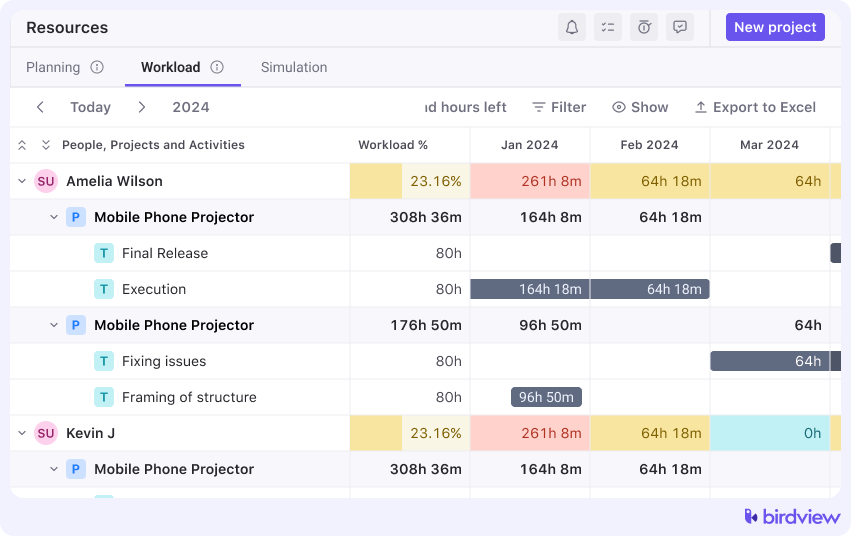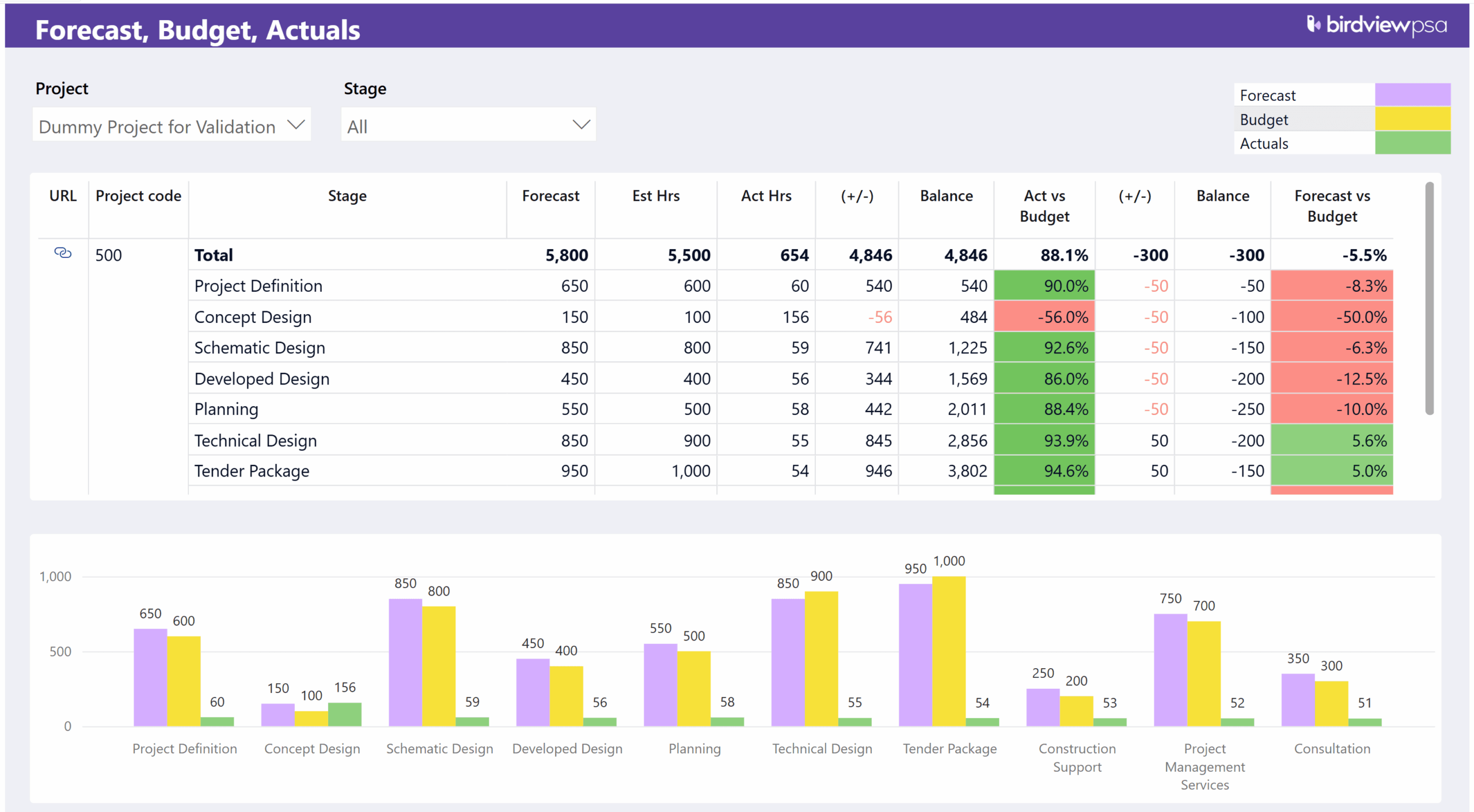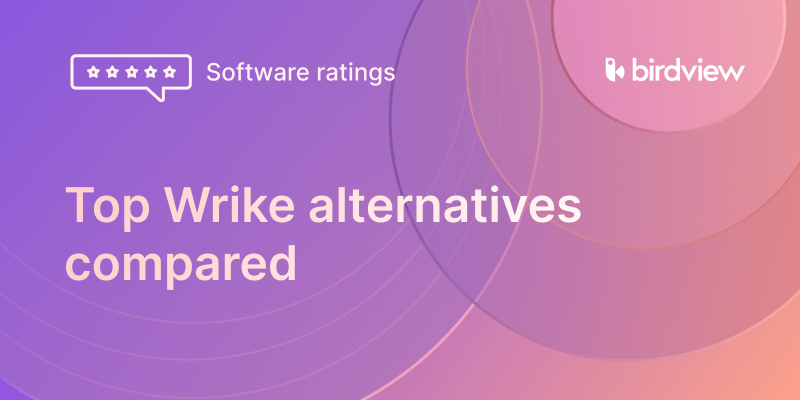This article will explore the unique demands of managing architecture projects and show you how Birdview PSA for architecture provides the integrated solution to streamline your process from the initial concept to the final handover.
Project management in architecture is a unique blend of creative vision and precise execution. As an architect, you’re not just designing beautiful spaces; you’re navigating complex projects with tight deadlines, intricate details, diverse stakeholders, and budgets that demand close attention. It‘s a world where spreadsheets multiply, communication can get tangled, and trying to see the whole picture feels nearly impossible.
You understand the constant challenge: how do you keep the design vision alive while ensuring the project stays on track, within budget, and complies with a myriad of regulations? How do you manage your team’s specialized skills and balance workloads across multiple projects without dropping the ball? You need a tool that understands the specific workflow of an architecture firm, not just a generic project tracker.
This is where specialized architecture project management software comes in. It‘s designed to bring clarity, control, and efficiency to your practice.
Let‘s design a clearer path to project success.
The unique challenges of architecture project management
Managing architectural projects isn’t like managing any other project. It requires a specific approach because of the unique blend of creative process and technical precision involved. Architects face challenges that go beyond typical project management woes:
- Blending design vision with project realities: The initial creative concept must constantly be reconciled with practical constraints like budget, timeline, building codes, and material availability. It’s a constant negotiation between the ideal and the achievable.
- Managing complex project structures: Architecture projects involve distinct phases (Schematic Design, Design Development, Construction Documents, etc.), each with specific deliverables and requirements. Breaking down and tracking progress through these intricate stages is crucial.
- Coordinating diverse stakeholders: Architects work with a wide array of individuals and groups – clients, structural engineers, mechanical engineers, landscape architects, interior designers, contractors, subcontractors, city planners, building inspectors, and more. Keeping everyone aligned and informed is a massive coordination effort.
- Tracking time, expenses, and billable hours accurately: For architecture firms offering professional services, accurately tracking every hour spent and expense incurred is vital for billing and profitability. Doing this across multiple projects and team members manually is incredibly time-consuming and prone to errors.
- Maintaining document control & managing revisions: Architectural projects generate vast amounts of documentation – drawings, specifications, contracts, permits, RFIs, submittals, and more. Keeping track of versions, ensuring the right people have access to the latest files, and managing revisions efficiently is a significant administrative burden.
- Resource allocation for specialized skills & fluctuating workloads: Architecture firms employ professionals with highly specialized skills. Allocating architects, designers, technologists, and support staff across concurrent projects with varying demands requires sophisticated resource planning to avoid overallocation or underutilization.
- Client communication & transparency: Keeping clients informed about project progress, design updates, budget status, and potential delays in a clear and accessible way is essential for managing expectations and building trust.
- Ensuring compliance & regulatory adherence: Architectural projects must comply with numerous building codes, zoning laws, environmental regulations, and safety standards. Tracking these requirements and ensuring they are met throughout the project lifecycle is critical.
These specific challenges highlight why a generic project management tool often falls short for architecture firms. You need a solution built with these complexities in mind.
Why generic PM tools fall short for architecture
While tools like spreadsheets, basic task managers, or even general PM software can help with some aspects of managing architectural projects, they typically lack the integrated features needed to handle the full scope:
- Disconnected data: Time tracking, budgeting, resource allocation, document management, and project planning often live in separate systems, leading to data silos and manual data entry.
- Lack of specialization: Generic tools don’t understand the unique phases, deliverables, and stakeholder relationships in architecture. They aren’t built to track things like permit approvals or RFI logs efficiently.
- Limited financial integration: Basic PM tools may not integrate project progress directly with financial metrics like billable hours, profitability, or budget burn rate, making it hard to manage project finances in real-time.
- Weak document control: Handling multiple versions of drawings and specifications across different collaborators requires more robust document management than a simple file-sharing link.
- Poor resource insight: Seeing who is available, who has specific skills (e.g., LEED certification, Revit expertise), and balancing their workload across multiple projects across different teams or departments is often difficult or impossible.
This is where a specialized PSA software tailored for industries like architecture becomes invaluable.
Birdview PSA for architecture: your integrated solution
Birdview PSA is designed to be that integrated solution for architecture firms. It‘s a Professional Services Automation (PSA) software that brings together project management, resource planning, financial tracking, and client collaboration into one unified platform, built to support your unique architectural workflow.
Here’s how Birdview PSA for architecture addresses the challenges you face:
☑️ Comprehensive project planning tailored for architecture
Birdview PSA allows you to structure your projects in a way that makes sense for architectural practice.
- WBS for architectural phases: Break down your projects into the specific phases you follow – Schematic Design, Design Development, Construction Documents, Bidding, Construction Administration, etc. You can easily create a hierarchical Work Breakdown Structure (WBS) within the Activity Center.

- Task management & dependencies: Define all the tasks within each phase, assign responsibilities, and set clear deadlines. Crucially, you can set dependencies between tasks (e.g., structural design must be completed before framing details begin), ensuring your project workflow follows the necessary sequence. Birdview PSA’s task management tools handle this with ease.
- Milestone tracking: Mark key project milestones like client approvals, permit submissions, tender issued dates, and construction phase completions. Track progress towards these critical points to ensure your project stays on schedule. Birdview PSA makes setting and tracking project milestones straightforward.
- Project templates for common architectural projects: Speed up project setup by creating and reusing templates for common project types (e.g., single-family residential, small commercial renovation, tenant improvement). Customize these templates for unique project requirements.
☑️ Mastering resource management in architecture
Effectively allocating architects, designers, technologists, and support staff across concurrent projects is critical. Birdview PSA’s resource management features provide the visibility and tools you need:
- Allocating architects, designers, technologists, etc.: Assign specific team members to tasks based on their availability and the effort required.
- Tracking specialized skills & certifications: Maintain a profile for each team member listing their skills (e.g., Revit proficiency, LEED AP certification, specific software expertise) and use filters to find the best fit for specialized tasks.
- Balancing workloads & preventing burnout: See your team’s workload visually. Birdview PSA highlights who is overbooked or underutilized, allowing you to reallocate tasks and balance workloads to prevent burnout and optimize productivity. Our resource utilization reports help identify imbalances.

- Forecasting resource needs for future projects: Use Birdview PSA to predict your team’s capacity for upcoming projects based on your pipeline and current commitments. This helps you anticipate hiring needs or adjust project timelines proactively.
☑️ Seamless financial management for architecture projects
Tracking time, expenses, and managing budgets is non-negotiable for architecture firms. Birdview PSA integrates financial management directly into your project workflow:
- Tracking time & billable hours accurately: Your team can easily log time against specific tasks and projects, differentiating between billable and non-billable hours. This is essential for accurate client billing. Birdview PSA’s time tracking software handles this.
- Managing project budgets & expenses: Set detailed project budgets and track actual costs (labor and expenses) against them in real-time. Monitor your burn rate and see your project’s financial health at any given moment.

- Monitoring project profitability & margins: Understand the profitability of each project. Birdview PSA helps you track revenue against costs, giving you insights into project margins so you can make informed decisions about pricing and resource allocation.
- Streamlining invoicing: Generate accurate invoices directly from tracked time and expenses. Birdview PSA supports various billing models relevant to architecture (e.g., hourly, fixed fee, phase-based).
☑️ Streamlining collaboration & communication
Architecture projects require constant communication and collaboration among many parties. Birdview PSA centralizes this:
- Centralized communication: Keep all project-related discussions, decisions, and feedback in one place using task-specific message boards. Avoid scattered email chains and ensure everyone has access to the full conversation history.
- Document management & version control: Attach drawings, specifications, photos, and other documents directly to relevant tasks. Track document versions to ensure everyone is working with the latest information. Birdview PSA integrates with tools like SharePoint and OneDrive for seamless file management.
- Client & stakeholder portals: Share project progress, key documents, and visual timelines with clients, engineers, and other external stakeholders through a secure, dedicated portal. Control what information they see and allow them to provide feedback and approvals directly within the system. This transparency enhances client satisfaction and reduces communication bottlenecks. Birdview PSA offers a client portal designed for this.
☑️ Actionable insights & reporting
Making informed decisions requires data. Birdview PSA’s reporting and BI tools provide the insights you need:
- Dashboards for real-time project health: Customize dashboards to see key metrics for all your projects at a glance – budget status, schedule adherence, resource workload, etc.
- Custom reports for client updates, financial analysis, resource utilization: Generate detailed reports on specific project aspects, tailored for internal review or sharing with clients and stakeholders. Birdview PSA’s Business Intelligence reporting helps you analyze data effectively.
☑️ Flexibility & customization for architectural workflows
Your architectural practice has unique workflows. Birdview PSA is built to adapt:
- Custom fields: Add custom fields to track architecture-specific data points within projects or tasks (e.g., building type, square footage, construction materials, permit status).
- Custom workflows: Configure custom statuses and workflows to match your specific review and approval processes (e.g., Design Review stages, Permit Submission process).
- Integration with key tools: Connect Birdview PSA with tools like Microsoft 365 (Outlook, Teams, SharePoint), and potentially explore API integrations for linking with specialized architectural software (like CAD/BIM tools for data exchange).
Choosing the right software for your architecture firm
Selecting the right architecture project management software is a significant decision. Here are some general tips, keeping the unique needs of architecture in mind:
- Look for industry-specific features: Prioritize tools that understand architectural workflows, phases, and deliverables. Features like robust document management for drawings, client portals for visual approvals, and the ability to track compliance points are particularly valuable.
- Consider integration capabilities: Evaluate how well the software integrates with tools you currently use, especially communication platforms (like Outlook), and potentially explore future integrations with design software (CAD/BIM), even if it’s via API or data import/export.
- Prioritize user experience and adoption: The tool needs to be easy for your entire team, from senior partners to junior technologists, to use. A clunky interface or steep learning curve will hinder adoption.
- Evaluate reporting and financial management: Ensure the software provides clear visibility into project budgets, costs, billable hours, and profitability. The ability to generate customizable reports for both internal analysis and client updates is key.
- Assess scalability and support: Choose a solution that can grow with your firm and provides reliable customer support and onboarding assistance.
Birdview PSA: Designed to elevate your architectural practice
Birdview PSA isn’t just another project management tool; it’s a PSA software built to support professional services like architecture. It understands the blend of creativity and business acumen required to succeed.
By providing an integrated platform for project planning, resource management, financial tracking, and collaboration, Birdview PSA for Architecture helps architecture firms like yours:
- Streamline operations: Reduce manual tasks and bring order to scattered data.
- Improve visibility: See the status of all projects, resources, and finances in real-time.
- Enhance collaboration: Facilitate communication and document sharing among diverse stakeholders.
- Increase profitability: Track costs accurately, manage budgets, and optimize billable hours.
- Deliver projects successfully: Stay on time, within budget, and meet client expectations consistently.
Managing architectural projects is complex, demanding a tool that understands the unique challenges of blending design vision with project execution. Birdview PSA for Architecture provides that integrated solution, offering comprehensive project management, robust resource management, seamless financial tracking, and powerful collaboration features all in one platform.
Stop wrestling with disconnected spreadsheets and generic tools. Give your team the clarity and control they need to focus on what they do best – creating inspiring designs and bringing them to life. With Birdview PSA, you can streamline your process from the initial plan to completion, ensuring design success at every stage.
Ready to see how Birdview PSA can elevate your architectural practice?
or
You may also like:



